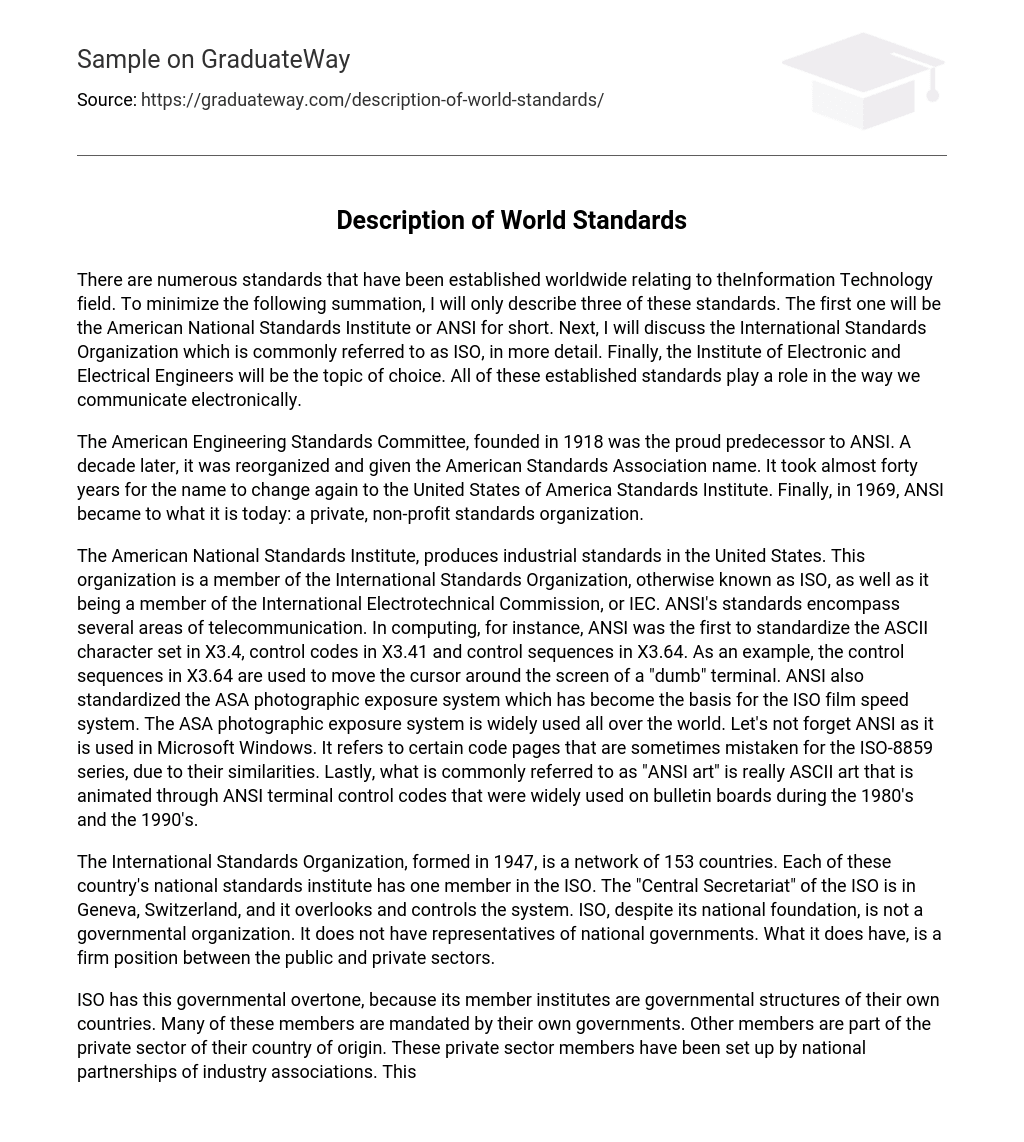There are numerous standards that have been established worldwide relating to the Information Technology field. To minimize the following summation, I will only describe three of these standards. The first one will be the American National Standards Institute or ANSI for short. Next, I will discuss the International Standards Organization which is commonly referred to as ISO, in more detail. Finally, the Institute of Electronic and Electrical Engineers will be the topic of choice. All of these established standards play a role in the way we communicate electronically.
The American Engineering Standards Committee, founded in 1918 was the proud predecessor to ANSI. A decade later, it was reorganized and given the American Standards Association name. It took almost forty years for the name to change again to the United States of America Standards Institute. Finally, in 1969, ANSI became to what it is today: a private, non-profit standards organization.
The American National Standards Institute, produces industrial standards in the United States. This organization is a member of the International Standards Organization, otherwise known as ISO, as well as it being a member of the International Electrotechnical Commission, or IEC. ANSI’s standards encompass several areas of telecommunication. In computing, for instance, ANSI was the first to standardize the ASCII character set in X3.4, control codes in X3.41 and control sequences in X3.64.
As an example, the control sequences in X3.64 are used to move the cursor around the screen of a “dumb” terminal. ANSI also standardized the ASA photographic exposure system which has become the basis for the ISO film speed system. The ASA photographic exposure system is widely used all over the world. Let’s not forget ANSI as it is used in Microsoft Windows. It refers to certain code pages that are sometimes mistaken for the ISO-8859 series, due to their similarities. Lastly, what is commonly referred to as “ANSI art” is really ASCII art that is animated through ANSI terminal control codes that were widely used on bulletin boards during the 1980’s and the 1990’s.
The International Standards Organization, formed in 1947, is a network of 153 countries. Each of these country’s national standards institute has one member in the ISO. The “Central Secretariat” of the ISO is in Geneva, Switzerland, and it overlooks and controls the system. ISO, despite its national foundation, is not a governmental organization. It does not have representatives of national governments. What it does have, is a firm position between the public and private sectors.
ISO has this governmental overtone, because its member institutes are governmental structures of their own countries. Many of these members are mandated by their own governments. Other members are part of the private sector of their country of origin. These private sector members have been set up by national partnerships of industry associations. This is why, ISO is an organization that can bridge the gap between the requirements of businesses and that of society such as consumers and users.
The Institute of Electronic and Electrical Engineers has more than 365,000 members in over 150 countries. It also has over 68,000 student members and more than 27,000 society affiliates. IEEE has more than 1,300 student branches in 80 countries and over 300 student branch chapters. To put it mildly, IEEE is huge.
The AIEE (American Institute of Electrical Engineers) and the IRE (Institute of Radio Engineers) were the founding organizations of what we know today as the IEEE. All of these institutions date back to 1884. Ever since its founding, the IEEE has made remarkable advances in the theory and application of electro technology and allied sciences. It was the engine behind many technological innovation and its programs and services fulfilled its members’ needs.
Due to the electronic advances of the nineteenth century, twenty-five of the most prominent electrical engineers in the United States have called for the formation of the AIEE in New York. The Institute of Radio Engineers was a group that mainly dealt with wireless communications. Many members of the IRE came from the AIEE and vice-versa. Finally, in 1963 the two groups have united their forces and came to be recognized as the IEEE.
With the technological advances and the assurance of standards to these advances, it is easy to see why various organizations came to be. Without them, these standards of practice and use would be chaotic. This is as much true worldwide as it is true in the United States.





